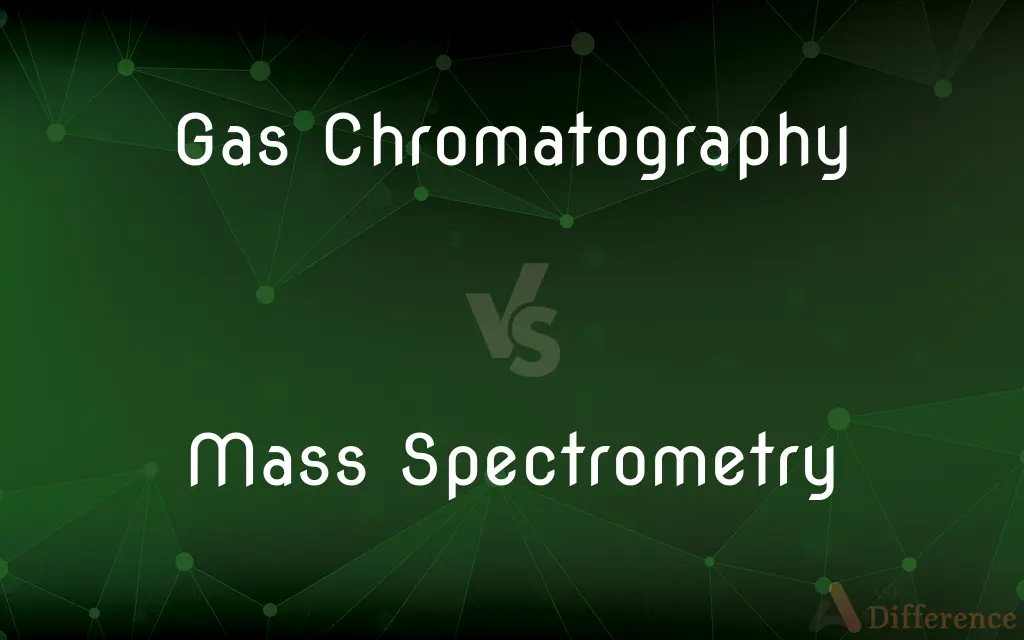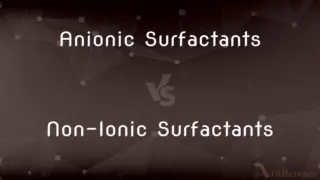Gas Chromatography vs. Mass Spectrometry — What's the Difference?
By Maham Liaqat & Urooj Arif — Published on February 21, 2024
Gas Chromatography separates mixtures based on volatility differences, while Mass Spectrometry identifies compounds by mass-to-charge ratios, offering detailed molecular insights.

Difference Between Gas Chromatography and Mass Spectrometry
Table of Contents
ADVERTISEMENT
Key Differences
Gas Chromatography (GC) is a technique used to separate and analyze compounds that can be vaporized without decomposition. It relies on a carrier gas and a stationary phase to separate different substances based on their volatility and interaction with the column material. In contrast, Mass Spectrometry (MS) identifies and quantifies compounds by ionizing chemical species and sorting the ions based on their mass-to-charge ratio. This method provides detailed information about the molecular structure and composition of the analytes.
GC is typically used for the analysis of volatile organic compounds, separating them based on their ability to travel through a column at different rates. MS, on the other hand, is capable of providing molecular weight information and structural insights, making it invaluable for identifying unknown compounds and elucidating complex mixtures.
One of the strengths of GC is its ability to separate complex mixtures into individual components, which can then be detected, usually by a flame ionization detector (FID) or a thermal conductivity detector (TCD). MS, however, excels in its detection capabilities, offering high sensitivity and specificity for the compounds of interest, even in trace amounts.
Combining GC with MS (GC-MS) leverages the separation capabilities of GC with the identification and quantification strengths of MS. This powerful combination is widely used in forensic science, environmental analysis, and metabolomics to analyze complex mixtures with high precision and accuracy.
GC is highly effective for the separation and analysis of volatile and semi-volatile compounds, while it cannot analyze very large or non-volatile molecules. MS, with its ability to analyze a wide range of compounds, from small organics to large biomolecules, complements GC by providing detailed information about the chemical nature of the separated compounds.
ADVERTISEMENT
Comparison Chart
Principle
Separation based on volatility and interaction with stationary phase
Identification based on mass-to-charge ratio of ions
Main Use
Separation and analysis of volatile compounds
Identification and quantification of compounds by mass
Detection
Indirect, requires a detector like FID or TCD
Direct, based on ion detection
Information Provided
Retention time, indicating compound's volatility
Mass spectrum, providing molecular weight and structure
Sample Requirement
Must be volatile or made volatile
Can analyze a wide range, including non-volatile compounds
Compare with Definitions
Gas Chromatography
Utilizes a stationary phase and a mobile gas phase.
In GC, nitrogen is often used as the carrier gas.
Mass Spectrometry
Can analyze a wide range of substances.
MS is used in proteomics to identify proteins in a sample.
Gas Chromatography
Requires compounds to be vaporized for analysis.
Samples for GC are often heated to become gaseous.
Mass Spectrometry
Highly sensitive and specific.
MS can detect trace levels of contaminants in water.
Gas Chromatography
A technique for separating chemical substances based on their volatility.
GC is used to analyze the aroma compounds in coffee.
Mass Spectrometry
Provides detailed molecular structure information.
MS can elucidate the structure of unknown pharmaceuticals.
Gas Chromatography
Often coupled with detectors for analysis.
GC-FID is a common setup for detecting organic compounds.
Mass Spectrometry
Involves ionization of sample molecules.
Electrospray ionization is a soft ionization technique used in MS.
Gas Chromatography
Provides separation efficiency for complex mixtures.
GC can separate the components of essential oils.
Mass Spectrometry
An analytical technique identifying compounds by their mass-to-charge ratio.
MS can determine the molecular weight of peptides.
Common Curiosities
Can GC and MS be used together?
Yes, GC-MS combines the separation power of GC with the identification capabilities of MS, providing detailed analysis of complex mixtures.
How does MS provide structural information?
MS provides structural information by breaking molecules into fragments and analyzing the mass and charge of these fragments.
Is GC or MS more sensitive?
MS is generally more sensitive than GC, capable of detecting trace amounts of substances.
How do GC and MS differ in their applications?
GC is primarily used for separating volatile compounds, while MS is used for identifying and quantifying molecules based on their mass.
What types of samples can be analyzed by MS?
MS can analyze a broad range of substances, from small molecules to large biomolecules, including non-volatile compounds.
What is Mass Spectrometry?
Mass Spectrometry is an analytical technique that measures the mass-to-charge ratio of charged particles to identify and quantify molecules.
What are the detection methods used in GC?
Common detectors in GC include the Flame Ionization Detector (FID) and Thermal Conductivity Detector (TCD).
What is Gas Chromatography?
Gas Chromatography is a method used to separate and analyze compounds that vaporize without decomposing.
How do ionization methods affect MS analysis?
The choice of ionization method in MS can significantly affect the analysis, as it determines the types of ions generated and their fragmentation patterns.
Can GC analyze non-volatile compounds?
GC cannot directly analyze non-volatile compounds; they must be derivatized into a volatile form for GC analysis.
What are some common applications of GC-MS?
GC-MS is widely used in forensic analysis, environmental testing, food and flavor analysis, and pharmaceuticals.
What types of samples can be analyzed by GC?
GC can analyze any compound that can be vaporized without decomposition, typically volatile and semi-volatile organic compounds.
How do temperature and pressure affect GC analysis?
In GC, temperature and pressure control the flow and interaction of the sample with the stationary phase, affecting separation efficiency.
What advancements have been made in MS technology?
Advances in MS technology include high-resolution mass spectrometers, improved ionization techniques, and better data analysis software, enhancing sensitivity and specificity.
What is the role of the stationary phase in GC?
The stationary phase in GC is a material that compounds adhere to temporarily, allowing their separation based on volatility and interaction.
Share Your Discovery

Previous Comparison
Anionic Surfactants vs. Non-Ionic Surfactants
Next Comparison
Pancakes vs. CrumpetsAuthor Spotlight
Written by
Maham LiaqatCo-written by
Urooj ArifUrooj is a skilled content writer at Ask Difference, known for her exceptional ability to simplify complex topics into engaging and informative content. With a passion for research and a flair for clear, concise writing, she consistently delivers articles that resonate with our diverse audience.













































